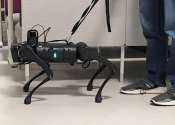Laser attack blinds autonomous vehicles, deleting pedestrians and confusing cars
Self-driving cars, like the human drivers that preceded them, need to see what's around them to avoid obstacles and drive safely.
Oct 31, 2022
4
266
Security

Self-driving cars, like the human drivers that preceded them, need to see what's around them to avoid obstacles and drive safely.
Oct 31, 2022
4
266
Engineering

Two researchers with the Center for Digital Technology and Management, Technical University of Munich, have developed a haptic feedback sleeve and goggle system that allows blind people to partially "see" with the skin on ...
Hi Tech & Innovation

A team of researchers at the University of Georgia has created a backpack equipped with AI gear aimed at replacing guide dogs and canes for the blind. Intel has published a News Byte describing the new technology on their ...
Robotics

A small team of researchers at the University of California, Berkeley has developed a robot dog to help in ways similar to real guide dogs. They have written a paper describing their robot guide dog and have uploaded it to ...
Engineering

Researchers at Bayreuth University have developed a digital-age speaker system that permits the blind to read Braille using ultrasound waves in mid-air.
Software

A team of researchers at Google Research has unveiled a new project they have been working on that uses AI technology to allow a blind person to follow a path without assistance. In their announcement of the project, called ...
Consumer & Gadgets

A new smartphone case could soon enable folks with visual impairments, tremors and spasms to use touch screens independently. Developed at the University of Michigan, BrushLens could help users perceive, locate and tap buttons ...
Oct 26, 2023
0
26
Consumer & Gadgets

Engineers at the University of Colorado Boulder are tapping into advances in artificial intelligence to develop a new kind of walking stick for people who are blind or visually impaired.
Jan 19, 2023
0
66
Robotics

Engineers from the Computer Science Department at Binghamton University, State University of New York have programmed a robot guide dog to assist the visually impaired. The robot responds to tugs on its leash.
Oct 30, 2023
0
170
Software

Google announced a boost to its Lookout app that will further assist visually impaired or blind users. Lookout allows users to point their camera at objects and then tell them what it sees. And it lets users scan text and ...
Blindness is the condition of lacking visual perception due to physiological or neurological factors.
Various scales have been developed to describe the extent of vision loss and define blindness. Total blindness is the complete lack of form and visual light perception and is clinically recorded as NLP, an abbreviation for "no light perception." Blindness is frequently used to describe severe visual impairment with residual vision. Those described as having only light perception have no more sight than the ability to tell light from dark and the general direction of a light source.
In order to determine which people may need special assistance because of their visual disabilities, various governmental jurisdictions have formulated more complex definitions referred to as legal blindness. In North America and most of Europe, legal blindness is defined as visual acuity (vision) of 20/200 (6/60) or less in the better eye with best correction possible. This means that a legally blind individual would have to stand 20 feet (6.1 m) from an object to see it—with vision correction—with the same degree of clarity as a normally sighted person could from 200 feet (61 m). In many areas, people with average acuity who nonetheless have a visual field of less than 20 degrees (the norm being 180 degrees) are also classified as being legally blind. Approximately ten percent of those deemed legally blind, by any measure, have no vision. The rest have some vision, from light perception alone to relatively good acuity. Low vision is sometimes used to describe visual acuities from 20/70 to 20/200.
By the 10th Revision of the WHO International Statistical Classification of Diseases, Injuries and Causes of Death, low vision is defined as visual acuity of less than 6/18 (20/60), but equal to or better than 3/60 (20/400), or corresponding visual field loss to less than 20 degrees, in the better eye with best possible correction. Blindness is defined as visual acuity of less than 3/60 (20/400), or corresponding visual field loss to less than 10 degrees, in the better eye with best possible correction.
It should be noted that blind people with undamaged eyes may still register light non-visually for the purpose of circadian entrainment to the 24-hour light/dark cycle. Light signals for this purpose travel through the retinohypothalamic tract, so a damaged optic nerve beyond where the retinohypothalamic tract exits it is no hindrance.
This text uses material from Wikipedia, licensed under CC BY-SA